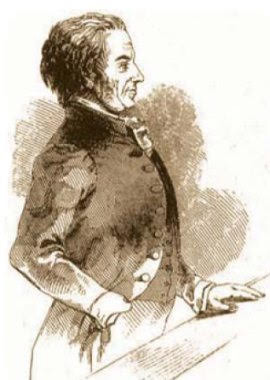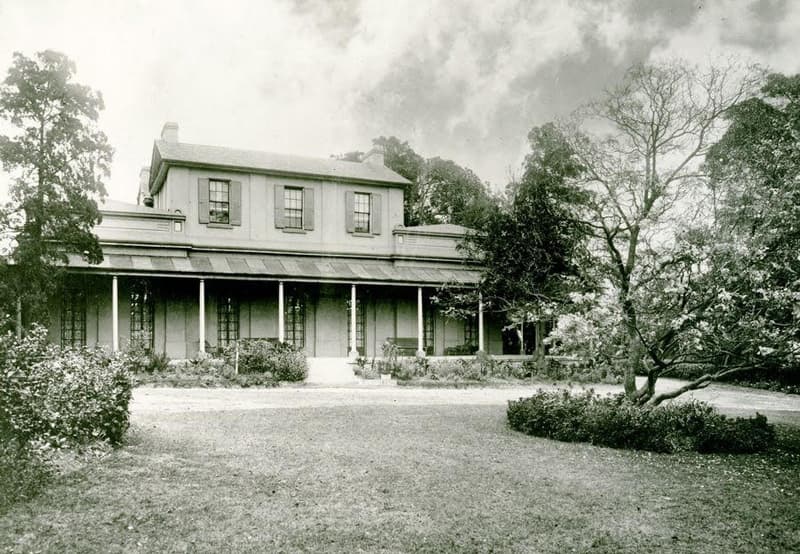
A plaque in Foley Park lists John Tawell as one of the occupants of Hereford House which stood on the site from 1829 until its demolition in the 1930s. Tawell is recorded as having lived there during the years 1831-5. (Druggist Ambrose Foss purchased Hereford House in 1833.) An ex-convict who ‘made good’, John Tawell came to a bad end.
A member of the Quaker community, Tawell was transported to Australia for 14 years for forging a Bank of England note. Punishable by death, the offence had been commuted after the bankers (who were Quakers) declined to prosecute. Leaving behind his wife Mary (née Freeman) and two sons, Tawell arrived in the colony in 1815 on the Marquis of Wellington. In England he had been a commercial traveller for a wholesale druggist and in Sydney he was not assigned to a settler but worked in the ‘Rum Hospital’. In 1820 he was emancipated and was granted a certificate of qualification by the Medical Board. Tawell set up as an apothecary in Hunter St before moving to bigger premises in Pitt St where he sold drugs with a sideline in groceries. He did well.
In 1822 Tawell applied to have his family brought out from London and Mary and her sons arrived in March 1823 aboard the Lord Sidmouth. The boys were educated at Dr Halloran’s Sydney Grammar School; in 1824 William Henry won a book prize and John Downing a silver medal for Latin. The Pitt St building, the family home until at least 1825, was gradually converted from timber to stone. In 1828 Ambrose Foss bought the business and by the time of that year’s census ‘retired apothecary’ John Tawell was living in Castlereagh St with his wife and their 17-year-old younger son William. John jnr was in England studying medicine.

As well as retailing and moneylending, Tawell speculated in oil and whaling, as a spinoff sending whalebone to London where it was fashioned into combs. He was granted 42 acres at Hunters Hill; other property included land at Camden, Bathurst, Berrima, Maitland, Goulburn and the Seven Stars Hotel and an adjoining building in King St in the city. By 1831 he had accumulated at least £35 000 and began advertising his services as an import/export agent.After arriving in London with a consignment of wool he was soon back on board a ship with return cargo for Sydney.
By 1836 Tawell was presenting himself as a member of both the Royal College of Surgeons and the Society of Apothecaries.He built a chapel for the Society of Friends in Macquarie St and made an official request for a Quaker burial ground.In his distinctive Quaker garments, Tawell was a model of philanthropic respectability.His reputation for probity was enhanced when he threw a large consignment of rum into the harbour.Viewed with dismay by those who would have drunk it, others were fulsome in their praise of the advocate of temperance.
Tawell made several trips back and forth to London. In March 1829 he embarked with his wife and William on the Henry Wellesley. A fortnight later John jnr turned up in Sydney from England to find the family gone. He immediately booked a return passage on the Australia. This illustrates the tyranny of distance. Before the arrival of the telegraph, news to the antipodes took months to travel by letter.
Tawell sailed with his wife from London to Sydney on the Caroline on 11 July 1834 after which the couple seem to have done no more travelling until their final departure in March 1838 on the Charles Kerr. A wealthy merchant with ‘Esq’ after his name, Tawell in 1836 was living with his wife in Macquarie St, a fashionable address.
Settled back in England, Tawell sought reacceptance into the Society of Friends, wearing their dress, attending their meetings and subscribing to their schools. But the Quakers had long memories and kept him at arm’s length. They remembered his crime and his shotgun marriage to a housemaid six years his junior, hastily arranged while he was courting a young woman from a respectable Quaker family.
Predeceased by her sons, Mary Tawell died from tuberculosis in England and in 1841 her widower married Sarah Cutforth, a well-to-do Quaker widow with a seven-year-old daughter. An inconvenient problem was his mistress Sarah Hart, who had nursed his dying wife and by whom he had two children. Tawell paid her an allowance and kept her in seclusion at Salt Hill near Slough. Fearful of detection and in financial difficulties, after one unsuccessful effort with morphia he poisoned her with prussic acid. Called by a neighbour, a doctor found Sarah Hart dead and followed Tawell to Slough railway station where he saw him board a train. He convinced the reluctant stationmaster to make use of the newly installed needle telegraph to wire ahead to Paddington. (As the needles could not transcribe the letter ‘Q’, Tawell was described as a ‘kwaker’.) When he alighted Tawell was recognised by his distinctive dress and arrested.
Tawell’s case was the first time the telegraph system was used to catch a criminal. Hanged in March 1845, he left considerable property in New South Wales. It was forfeited to the Crown. As was customary, the wrongdoer’s crime and punishment was the subject of at least one broadside ballad:
John Tawell is my name it is true.
In wealth and splendour once I’ve dwelt,
A hypocrite I’ve always been,
Nor meek-ey’d mercy never felt.
My first crime was Forgery,
A convict was to Sidney sent,
I riches gain’d oh! Misery,
My stubborn heart did not relent…
Lyn Collingwood
Local Historian
Sources: murderpedia.org; NSW 1828 Census; NSW State Records; Trove website; Wikipedia: John Tawell; www.btp.police.uk; www.oldpolicecellsmuseum.org.uk









One comment. Please add yours.
The spellings “gust” and “Kwaker” were needed as the two-wire telegraph system had no codes for J, Q or Z.